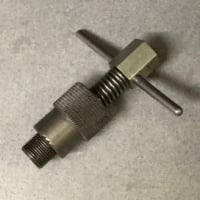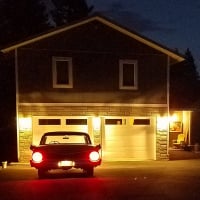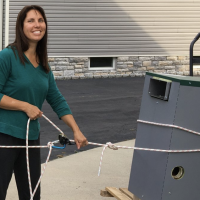Weil Mclain boiler replacement
Comments
-
How do you know its the right size?
Do you have a manometer and a combustion analyzer?There was an error rendering this rich post.
0 -
Do a heat loss analysis first. Then, and only then, can you decide whether that is the proper boiler for your application.
Once you get whatever you decide to put in installed, you will have to tune it up -- and for that you will need a manometer or sensitive pressure gauge and a combustion analyser -- and know how to use them.Br. Jamie, osb
Building superintendent/caretaker, 7200 sq. ft. historic house museum with dependencies in New England1 -
What ^ said.
Can you post pics of the existing?
Is the existing piped primary/secondary, as it should?
Are you up to date with you're codes? BFP, LWCO, etc. ?0 -
A picture of the current boiler installed. It's on three zones, basement, first floor, second floor. As far as a heat loss calc goes just by chance I had the gentleman who did the original install out a few years ago to look at something on the boiler. He said they did a calculation at that time which resulted in the current sizing, is it necessary to do another one? Not much has changed on the house since then...0
-
I do not own a manometer or combustion analyser, however they are both readily and inexpensively available through ebay/craigslist. I completely understand it's always better to hire a seasoned professional but in my world there is a big difference between say $ if I do it myself and $ to have someone do it for me...0
-
Can you take some shots from farther away and from different angles? The boiler and connected piping.
You're only worth $? Family?
Your not patching drywall or adjusting the rear slider. Both of which are on my list, but somehow I'm sitting on the patio on a lazy Sunday afternoon0 -
@Weld_fix, I’m reminded of when another homeowner (years ago) posted his DIY boiler install. He said he didn’t want to hire a professional because he thought they would rip him off and endanger his family with their poor install. The pictures he posted proved to show he did the exact thing he was trying to avoid. The install was wrong on a number of levels and he himself ended up endangering his family. I’m not saying you can’t do it as I don’t know your level of experience and I admire you for trying to take the task on, but I would advise against it.0
-
fyi... the gv 90 plus does indicate it can be piped in and out if it meets specific criteria. Im guessing yours will not..either way I STRONGLY recommend you pipe it primary/secondary. Next question would be, where do you live? Does your state allow you to install it? Will your insurance company cover you if you make a mistake (why we carry big insurance) there are more than just plug and play
1 -
Why do you guess my current system will not meet the criteria to be piped in/out on a GV 90? I live in MN and I'm sure I can install it myself as long as I pull a permit. However that's kind of a moot point as I'm one of those libertarian types who believes I should be able to do what I want on my own personal property. However I don't want to get sidetracked by opening that can of worms.....lchmb said:fyi... the gv 90 plus does indicate it can be piped in and out if it meets specific criteria. Im guessing yours will not..either way I STRONGLY recommend you pipe it primary/secondary. Next question would be, where do you live? Does your state allow you to install it? Will your insurance company cover you if you make a mistake (why we carry big insurance) there are more than just plug and play
Of course there's always the option of fixing my current boiler, for the last few weeks of the previous heating season it would only run with the vent cover removed from the outside of the house. In other words with the exhaust pipe exiting straight out the house uninhibited by anything even slightly restricting exhaust flow...0 -
Whatever... go for it. It's your nickel.Br. Jamie, osb
Building superintendent/caretaker, 7200 sq. ft. historic house museum with dependencies in New England0 -
I prefer to do my own work as well...up to a point. I have zero issue paying a professional to connect the gas piping, check my venting work, and perform the initial firing and combustion analysis. I also always pull a permit and have the requisite inspection done. Not worth the possibility of what *could* happen to me, my house, or my family. I get the “I’ll do it myself” attitude. I really do. But if something goes wrong, even 5-10 years down the road, with the work YOU did, and god forbid someone gets hurt, there’s no one to blame (or sue) except yourself. And I know from experience that any insurance company involved will laugh you right off the phone. I learned my lesson - hell, just yesterday I pulled a $30 permit to replace a rotten section of wood fence in my backyard. Cheap insurance to do it correctly & legally.Ford Master Technician, "Tinkerer of Terror"
Police & Fire Equipment Lead Mechanic, NW WI
Lover of Old Homes & Gravity Hot Water Systems0 -
> @Weld_fix said:
>
> Why do you guess my current system will not meet the criteria to be piped in/out on a GV 90?
Well, because @Ichmb wasn't guessing. It's in the manual you read completely. (See diagrams)
Even if you have zone valves and using only the internal system circulator, primary/secondary is preferred to most in the trade. Especially when the manufacturers literature shows it.
These guys are here to help, not hinder, so just because you dont agree with the advice and recommendations given, they're given in the interest of safety first.1 -
Thanks for all the input so far guys, I really appreciate it. I can pipe it primary/secondary as I know that's the current preferred method. For those of you who's knee jerk response is you're an idiot if you think you can do this yourself, you're going to kill you're family, etc. You're certainly entitled to you're opinion and I take no offense but I'm looking for constructive criticism and recommendations. I'm not sending someone to Mars, I'm installing a boiler. I know there's intricacies that you learn through experience but I know how to read and use logic and will continue with the install myself. It will take me a month or two of spare time to get it done and I will post pics along the way. If you see me do something dumb feel free to call me a moron and laugh in my face at that point, until then please reserve your baseless criticism.2
-
Have a blast!0
-
Weld Fix, I have a 1996 GV-4, gold series 2, 105,000 btuh input sitting in my basement. It was working fine when I replaced it with a Lochinvar Modcon. I have mostly infloor heating.
Call 402-340-5314 or PM me.
I am in northern NE, just considered a short trip in the Midwest for us......only 1 1/2 states away.0 -
Thanks for the offer, I wish I would have seen this sooner! I was just lucky enough to pick up a really nice GV-4 series 4 cheap. Anybody know what efficiency a series 1 is? i can't find it listed on my boiler anywhere. It says on the series 4 I just picked up it has a rating of 87.3 AFUE, just curious how much more efficient (if at all) it is than my current one.JUGHNE said:Weld Fix, I have a 1996 GV-4, gold series 2, 105,000 btuh input sitting in my basement. It was working fine when I replaced it with a Lochinvar Modcon. I have mostly infloor heating.
Call 402-340-5314 or PM me.
I am in northern NE, just considered a short trip in the Midwest for us......only 1 1/2 states away.0 -
DIY of gas boiler installations have several risks. Local AHJ have requirements for permits and licensed installers. If an incident would occur, there are a number of legal issues including refusal of the insurance company to pay and potential legal pursuits by the AHJ and other local and state agencies.0
-
Found the problem with my current unit, this is looking into the exhaust elbow coming off the boiler. It wasn't completely plugged, but about halfway. Looks like bits of rust...0
-
Looks like you need to go a lot deeper into this if there is that much scale in the elbow.I believe it will require some serious cleaning inside.
The GV90+ is a condensing boiler if I remember right, which means you will also have to change the exhaust system, and have a place for the condensate to go.
Also, the exhaust gasket is cracked which doesn't surprise me. This is why I don't like gaskets in an exhaust system. I have seen too many like this. Say what you want to about PVC, but the joints don't leak over time. At least none I have ever come across.
Also, like you, I do all my own work, but know when to bring in the right help when needed. In my area there are no permits for anything, as there are no inspectors. ( except in the city limits themselves.) But what you have to think about is if and when it comes time to sell your house, are the next people going to be buying something that is done right. Again I do not know your skill level, just saying.
Rick1 -
> @rick in Alaska said:
> Looks like you need to go a lot deeper into this if there is that much scale in the elbow.I believe it will require some serious cleaning inside.
> The GV90+ is a condensing boiler if I remember right, which means you will also have to change the exhaust system, and have a place for the condensate to go.
> Also, the exhaust gasket is cracked which doesn't surprise me. This is why I don't like gaskets in an exhaust system. I have seen too many like this. Say what you want to about PVC, but the joints don't leak over time. At least none I have ever come across.
> Also, like you, I do all my own work, but know when to bring in the right help when needed. In my area there are no permits for anything, as there are no inspectors. ( except in the city limits themselves.) But what you have to think about is if and when it comes time to sell your house, are the next people going to be buying something that is done right. Again I do not know your skill level, just saying.
> Rick
The series 4 I will be installing uses a T off the boiler with a drain on the bottom of that. I will running all new exhaust when I install it.0 -
I had the SS piping upgrade on my WM series 4, the furnished components included a tee with drain to be installed in the horizonal discharge vent just before leaving the building.
A drain tube with loop trap was attached.
This collects a fair amount of condensate.
That WM is a "nearly" condensing boiler.
The internal thermostatic mixing valve usually fails and you end up with too cold of water return thru the CI exchanger.
Probably happen to your old one and also on your "new" one.0 -
So if my understanding is correct too cold return water results in more condensation which is bad for the HX? What are your thoughts on insulating boiler piping as much as possible, does it make any real difference on a baseboard system? Also I think I read somewhere about some kind of anti condensing valve that goes on the return piping, I'll have to research them more. Does anyone have experience with them?0
-
I just found the tech service bulletin #SB0401R1 2-25-04 concerning GV series 1 & 2 has issues with internal condensation caused by the failure of a internal mixing valve.
Series 3 & 4 had the problem corrected with a bypass circulator instead of a mixing valve.
You should get and read the I&O manual for the series 4.
Your pictures of the discharge elbow full of rust indicates you may have had the internal mixing valve fail and allowed cool water to return into the boiler.0 -
I never meant to imply you were not able to do the job. I've installed a number of the GV90 plus. Excellent unit, very quiet, very east to set up. But I've never had good luck with in/out piping even when meeting the requirements. I was just trying to save you the hassle of it melting the circulator gaskets and having to repipe it..1
-
Well it's in finally. I went from a GV 4 series 1 to a series 4. I also switched it over from a closed style expansion tank to a bladder style and also added a Spirovent, auto fill valve and backflow preventer which my original system lacked. I verified incoming gas pressure at 10.5 inches of water column. I purchased a new starter tee and gasket as the one that came with it was pretty rotten, instead of buying that overpriced stainless vent pipe I fabbed up my own out of 3" 304 stainless tube. It's in two pieces, connected with a triclover fitting in the middle. When I first fired it the baseboards didn't seem to be getting as warm as they used too so I switched the main circulator pump from the Taco 007-F5 that came on it with a Grundfos UP15-42F off my old boiler. That made a huge difference. As far as I can tell everything is working as it should, let me know what you guys think.0
-
-
> @rick in Alaska said:
> Is it just the way the solder looks, or did the return line ball valve shift during soldering? It looks like it is not in the same place it started when it was first soldered, and is only half on. You might want to check it out.
> Rick
Yeah no it's all the way on, that's just a sloppy soldering job hahaha. I'm picky about that stuff but was offered help that day and didn't want to refuse it seeing as how it was 10° outside the day I switched over and I wanted to make it happen as fast as possible. So some of them aren't the prettiest but none of them leaked1 -
That helper must have stock in Oatley.
 0
0 -
Glad, it works for you. Seems like a bit of odd approach to replace the internal pump with a bigger one, and not consider a P/S arrangement.Weld_fix said:Well it's in finally. I went from a GV 4 series 1 to a series 4. I also switched it over from a closed style expansion tank to a bladder style and also added a Spirovent, auto fill valve and backflow preventer which my original system lacked. I verified incoming gas pressure at 10.5 inches of water column. I purchased a new starter tee and gasket as the one that came with it was pretty rotten, instead of buying that overpriced stainless vent pipe I fabbed up my own out of 3" 304 stainless tube. It's in two pieces, connected with a triclover fitting in the middle. When I first fired it the baseboards didn't seem to be getting as warm as they used too so I switched the main circulator pump from the Taco 007-F5 that came on it with a Grundfos UP15-42F off my old boiler. That made a huge difference. As far as I can tell everything is working as it should, let me know what you guys think.
Why not leave the boiler unmodified and just use the Grundfos as a secondary pump? Just a couple tee's and a bit of 120v wiring would do the trick.0 -
What does the series 4 boiler have for condensation protection from low return water temps.
The first series 1 & 2 had an internal mixing valve that had a high rate of failure....this may have produced the iron rust in the exhaust elbow of your first boiler. It was starting in my old one.0 -
> @JUGHNE said:
> What does the series 4 boiler have for condensation protection from low return water temps.
> The first series 1 & 2 had an internal mixing valve that had a high rate of failure....this may have produced the iron rust in the exhaust elbow of your first boiler. It was starting in my old one.
The series 4 has two internal pumps, a primary and a secondary. The secondary pump mixes return water to reduce condensation. If I remember right they claim it can handle return water temps as low as 60°.1 -
> @SuperJ said:
> Well it's in finally. I went from a GV 4 series 1 to a series 4. I also switched it over from a closed style expansion tank to a bladder style and also added a Spirovent, auto fill valve and backflow preventer which my original system lacked. I verified incoming gas pressure at 10.5 inches of water column. I purchased a new starter tee and gasket as the one that came with it was pretty rotten, instead of buying that overpriced stainless vent pipe I fabbed up my own out of 3" 304 stainless tube. It's in two pieces, connected with a triclover fitting in the middle. When I first fired it the baseboards didn't seem to be getting as warm as they used too so I switched the main circulator pump from the Taco 007-F5 that came on it with a Grundfos UP15-42F off my old boiler. That made a huge difference. As far as I can tell everything is working as it should, let me know what you guys think.
>
> Glad, it works for you. Seems like a bit of odd approach to replace the internal pump with a bigger one, and not consider a P/S arrangement.
> Why not leave the boiler unmodified and just use the Grundfos as a secondary pump? Just a couple tee's and a bit of 120v wiring would do the trick.
I'm sure that would have been a better way to go, I'm not a heating expert (obviously lol) so I just did what made sense to me at the time. Plus I was trying to keep as much of the original piping as possible intact just to keep things simple.0 -
I did not read all the post but I will just say IMO those boilers are junk. Get any boiler but that one.0
-
> @unclejohn said:
> I did not read all the post but I will just say IMO those boilers are junk. Get any boiler but that one.
You may be right, all I can say is the one I just pulled out ran for over twenty years. Not sure what the typical life span of a boiler is...0
Categories
- All Categories
- 87.4K THE MAIN WALL
- 3.2K A-C, Heat Pumps & Refrigeration
- 61 Biomass
- 429 Carbon Monoxide Awareness
- 120 Chimneys & Flues
- 2.1K Domestic Hot Water
- 5.8K Gas Heating
- 115 Geothermal
- 167 Indoor-Air Quality
- 3.7K Oil Heating
- 77 Pipe Deterioration
- 1K Plumbing
- 6.5K Radiant Heating
- 395 Solar
- 15.7K Strictly Steam
- 3.4K Thermostats and Controls
- 56 Water Quality
- 51 Industry Classes
- 50 Job Opportunities
- 18 Recall Announcements







